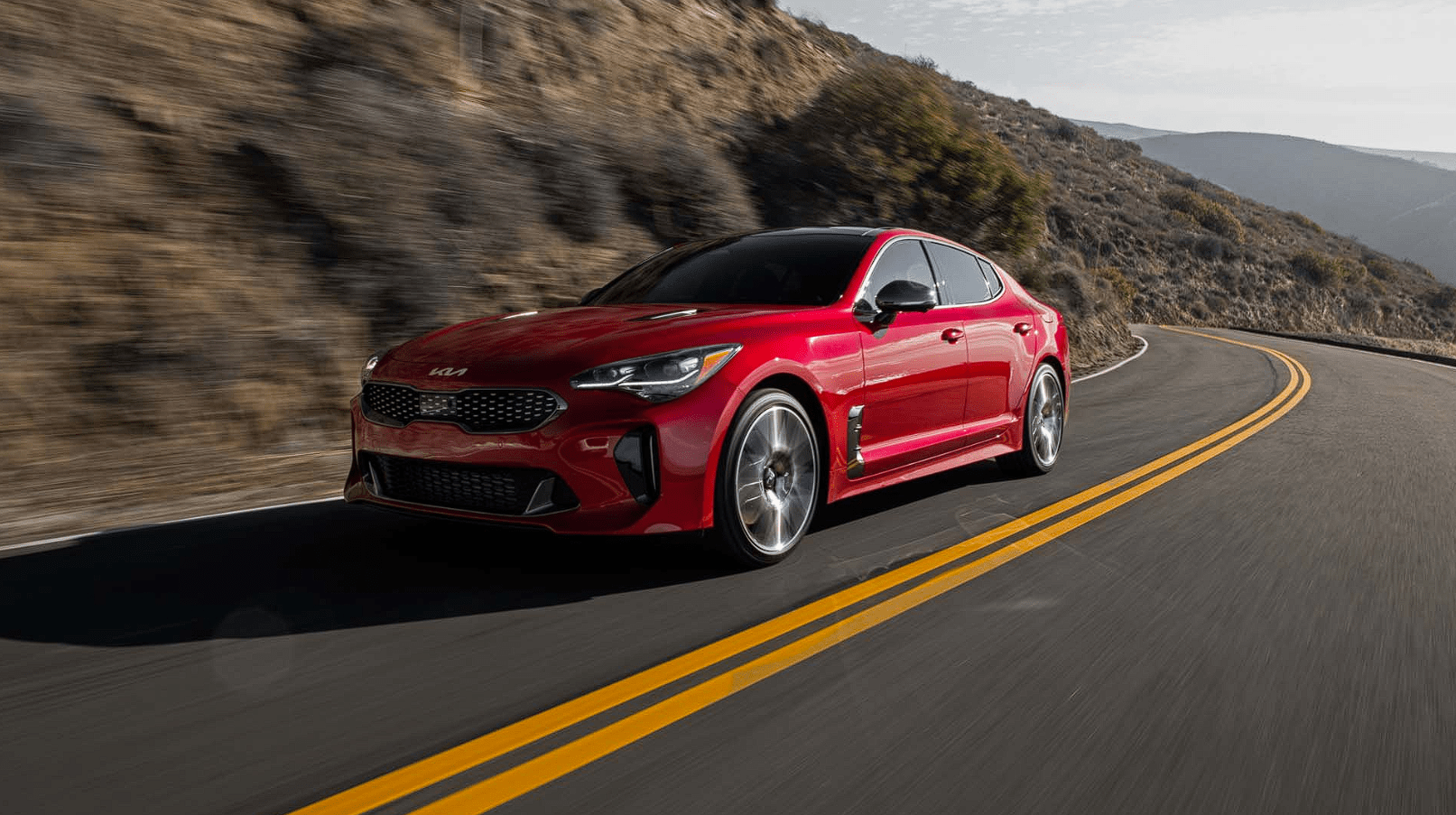Kia Stinger 2022 Using Of Brake System
When it comes to cars, safety is very important, and the stopping system is one of the most important parts for keeping you safe on the road. The 2022 Kia Stinger’s brake system is not only an important safety feature, it’s also an important part of what makes this sports car fun to drive and well-rounded. The Stinger’s brakes are made to give you both precision and control. They come with basic four-wheel disc brakes and performance-enhancing options like Brembo brakes. As part of this in-depth look, we’ll go over the 2022 Kia Stinger’s brake system in great detail, looking at its features, functions, and the technology that makes it possible to stop this sporty sedan safely, whether you’re driving slowly in the city or speeding through the countryside. Put on your seatbelts, because we’re going on a trip to find out how the 2022 Kia Stinger’s brake system works.
2023 Kia Stinger Specs, Price, Features and Mileage (Brochure)
Brake system
Power brakes
Your vehicle has power-assisted brakes that adjust automatically through normal usage.
In the event that the power-assisted brakes lose power because of a stalled engine or some other reason, you can still stop your vehicle by applying greater force to the brake pedal than you normally would. The stopping distance, however, will be longer.
When the engine is not running, the reserve brake power is partially depleted each time the brake pedal is applied. Do not pump the brake pedal when the power assist has been interrupted.
Pump the brake pedal only when necessary to maintain steering control on slippery surfaces.
CAUTION
Brake Pedal
Do not drive with your foot resting on the brake pedal. This will create abnormally high brake temperatures which can cause excessive brake lining and pad wear.
WARNING
Steep hill braking
Avoid continuous application of the brakes when descending a long or steep hill by shifting to a lower gear. Continuous brake application will cause the brakes to overheat and could result in a temporary loss of braking performance.
Wet brakes may impair the vehicle’s ability to safely slow down; the vehicle may also pull to one side when the brakes are applied. Apply-ing the brakes lightly will indicate whether they have been affected in this way. Always test your brakes in this fashion after driving through deep water. To dry the brakes, apply them lightly while maintaining a safe forward speed until brake performance returns to normal.
In the event of brake failure
If the service brakes fail to operate while the vehicle is in motion, you can make an emergency stop with the parking brake. The stopping distance, however, will be much greater than normal.
WARNING
Parking brake
Avoid applying the parking brake to stop the vehicle while it is moving except in an emergency situation. Applying the parking brake while the vehicle is moving at normal speeds can cause a sudden loss of control of the vehicle. If you must use the parking brake to stop the vehicle, use great caution in applying the brake.
Disc brakes wear indicator
When your brake pads are worn and new pads are required, you will hear a high-pitched warning sound from your front brakes or rear brakes. You may hear this sound come and go or it may occur whenever you depress the brake pedal.
Please remember that some driving conditions or climates may cause a brake squeal when you first apply (or lightly apply) the brakes. This is normal and does not indicate a problem with your brakes.
Always replace the front or rear brake pads as pairs.
CAUTION
Replace brake pads
Do not continue to drive with worn brake pads. Continuing to drive with worn brake pads can damage the braking system and result in costly brake repairs.
WARNING
Brake wear
Do not ignore high-pitched wear sounds from your brakes. If you ignore this audible warning, you will eventually lose braking performance, which could lead to a serious accident.
Brembo Brake (if equipped)
It is normal for vehicles equipped with high-performance brakes (Large-diameter Brembo brakes for enhanced braking performance) to generate braking noises.
Also, Circular patterns caused by disc surface friction may occur. These patterns are normal and do not affect braking performance. damage. The limited warranty does not cover damage caused by excessive, high speed, repetitive braking, track driving, racing, or other abuse or misuse of the vehicle.
Check the brake warning light by turning the ENGINE START/STOP button ON (do not start the engine). This light will be illuminated when the parking brake is applied with the ENGINE START/STOP button in the START or ON position.
Before driving, be sure the parking brake is fully released and the brake warning light is off.
If the brake warning light remains on after the parking brake is released while the engine is running, there may be a malfunction in the brake system. Immediate attention is necessary.
If at all possible, cease driving the vehicle immediately. If that is not possible, use extreme caution while operating the vehicle and only continue to drive the vehicle until you can reach a safe location or repair shop.
Electronic Parking Brake
Applying the parking brake
To apply the EPB (electronic parking brake):
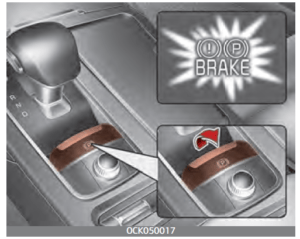
- Depress the brake pedal.
- Pull up the EPB switch.
Make sure the warning light comes on.
Also, the EPB has applied automatically if the Auto Hold button is on when the engine is turned off. However, if you pull up the EPB switch after the engine is turned off, the EPB will not be applied.
Make sure the warning light comes on.
Also, the EPB has applied automatically if the Auto Hold button is on when the engine is turned off. However, if you pull up the EPB switch after the engine is turned off, the EPB will not be applied.
NOTICE
On a steep incline or when pulling a trailer, if the vehicle does not remain at a standstill, do as follows:
- Apply the EPB.
- Pull up the EPB switch for more than 3 seconds.
Do not operate the EPB while the vehicle is moving except in an emergency situation.
NOTICE
A click or electric brake motor whine sound may be heard while operating or releasing the EPB. These conditions are normal and indicate that the EPB is functioning properly.
Releasing the parking brake
To release the EPB (electronic parking brake), press the EPB switch while doing the following:
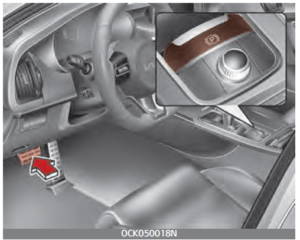
- Have the ENGINE START/STOP button in the ON position.
- Depress the brake pedal.
- The shift lever must be in P (Park).
Make sure the brake warning light goes off.
To release EPB (electronic parking brake) automatically:
- Shift lever in P (Park) With the engine running depress the brake pedal and shift out of P (Park) to R (Reverse) or D (Drive).
- Shift lever in N (Neutral) With the engine running depress the brake pedal and shift out of N (Neutral) to R (Reverse) or D (Drive).
Automatic Transmission
- . Close the driver’s door, engine hood, and liftgate.
- Fasten the driver’s seat belt. 3. Start the engine.
- Depress the accelerator pedal while the shift lever is in R (Reverse), D (Drive) or Sports mode.
Make sure the brake warning light goes off.
NOTICE
- For your safety, you can engage the EPB even though the ENGINE START/STOP button is in the OFF position, but you cannot release it.
- For your safety, depress the brake pedal and release the parking brake manually with the EPB switch when you drive downhill or when backing up the vehicle.
Do not follow the above procedure when driving on flat level ground. The vehicle may suddenly move forward.
NOTICE
If the parking brake warning light is still on even though the EPB has been released, have the system checked by an authorized Kia dealer.
CAUTION
Do not drive your vehicle with the EPB applied. It may cause excessive brake pad and brake rotor wear.
EPB (electronic parking brake) may be automatically applied when:
- The EPB is overheated
- Requested by other systems
NOTICE
For EPB (Electronic Parking Brake) equipped vehicles with AUTO HOLD function used while driving, if the ENGINE START/STOP button has been turned OFF, the EPB will be engaged automatically. Therefore, the AUTO HOLD function should be turned off before the ENGINE START/STOP button is turned off.
System warning

- If you try to drive off by depressing the accelerator pedal with the EPB applied, but the EPB doesn’t release automatically, a warning will sound and a message will appear.
- If the driver’s seat belt is not fastened and the engine hood, driver’s door, or liftgate is opened, a warning will sound and a message will appear.
- If there is a problem with the vehicle, a warning may sound and a message may appear.
- If the above situation occurs, depress the brake pedal and release EPB by pressing the EPB switch.
WARNING
Parking Brake Use
All vehicles should always have the parking brake fully engaged when parked to avoid inadvertent movement of the car which can injure occupants or pedestrians.
- A click or electric brake motor whine sound may be heard while operating or releasing the EPB. These conditions are normal and indicate that the EPB is functioning properly.
- When leaving your keys with a parking lot attendant or valet, make sure to inform him/her how to operate the EPB.
- The EPB may malfunction if you drive with the EPB applied.
- When you automatically release EPB by depressing the accelerator pedal, depress it slowly.
System warning
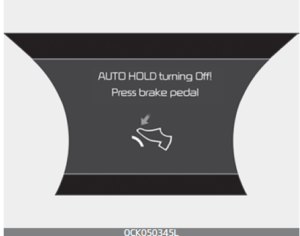
When the conversion from Auto Hold to EPB is not working properly, a warning will sound and a message will appear.
NOTICE
Depress the brake pedal when the above message appears for the Auto Hold and EPB may not activate.
System warning
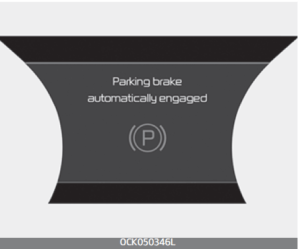
If the EPB is applied while Auto Hold is activated because of an ESC
(Electronic Stability Control) signal, a warning will sound and a message will appear.
EPB malfunction indicator
Type A
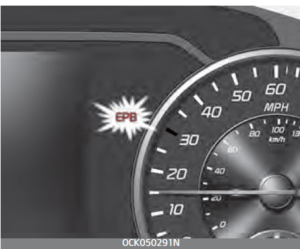
Type B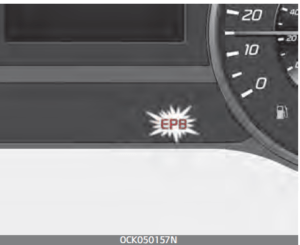
This warning light illuminates if the ENGINE START/STOP button is changed to the ON position and goes off in approximately 3 seconds if the system is operating normally.
If the EPB malfunction indicator remains on, comes on while driving, or does not come on when the ENGINE START/STOP button is changed to the ON position, this indicates that the EPB may have malfunctioned.
If this occurs, have your vehicle checked by an authorized Kia dealer as soon as possible.
The EPB malfunction indicator may illuminate when the ESC indicator comes on to indicate that the ESC is not working properly, but it does not indicate a malfunction of the EPB.
- The EPB warning light may illuminate if the EPB switch operates abnormally. Shut the engine off and turn it on again after a few minutes. The warning light will go off and the EPB switch will operate normally. However, if the EPB warning light is still on, have the system checked by an authorized Kia dealer.
- If the parking brake warning light does not illuminate or blinks even though the EPB switch was pulled up, the EPB is not applied.
- If the parking brake warning light blinks when the EPB warning light is on, press the EPB switch, then pull it up. Once more press it back to its original position and pull it back up. If the EPB warning does not go off, have the system checked by an authorized Kia dealer.
Emergency braking
If there is a problem with the brake pedal while driving, emergency braking is possible by pulling up and holding the EPB switch. Braking is possible only while you are holding the EPB switch.
WARNING
Do not operate the electronic parking brake while the vehicle is moving except in an emergency situation. Applying the electronic parking brake while the vehicle is moving at normal speeds can cause a sudden loss of control of the vehicle. If you must use the electronic parking brake to stop the vehicle, use great caution in applying the brake.
NOTICE
During emergency braking by the EPB, the parking brake warning light will illuminate to indicate that the system is operating.
If you notice a continuous noise or burning smell when the EPB is used for emergency braking, have your vehicle checked by an authorized Kia dealer.
When the EPB (electronic parking brake) is not released
If the EPB does not release normally, take your vehicle to an authorized Kia dealer by loading the vehicle on a flatbed tow truck and have the system checked.
Auto Hold
The Auto Hold maintains the vehicle in a standstill even though the brake pedal is not depressed after the driver brings the vehicle to a complete stop by depressing the brake pedal.
- Depress the brake pedal, start the engine and then press the AUTO HOLD button. The white AUTO HOLD indicator will come on indicating the system is in standby. Before the Auto Hold will engage, the driver’s door and engine hood must be closed and the driver’s seat belt must be fastened.

- . When coming to a complete stop by depressing the brake pedal, the AUTO HOLD indicator changes from white to green indicating the AUTO HOLD is engaged. The vehicle will remain at a standstill even if you release the brake pedal.
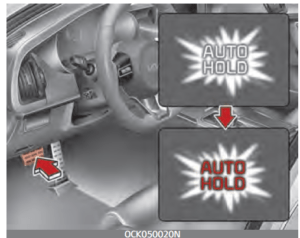
- If EPB is applied, Auto Hold will be released.
- If you press the accelerator pedal with the shift lever in D (Drive), R (Reverse) or manual mode, the
Auto Hold will be released automatically and the vehicle will start to move. The indicator changes from green to white indicating the Auto Hold is in standby and the EPB is released.
When driving off from Auto Hold by depressing the accelerator pedal, always check the surrounding area near your vehicle.
Slowly depress the accelerator pedal for a smooth launch.
Cancel
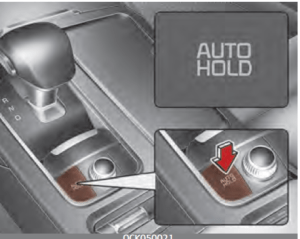
To cancel the AUTO HOLD operation, press the Auto Hold switch. The AUTO HOLD indicator will go out.
To cancel the Auto Hold operation when the vehicle is at a standstill, press the AUTO HOLD switch while depressing the brake pedal.
NOTICE
- The following are conditions when the Auto Hold will not engage (AUTO HOLD light will not turn green and the Auto Hold system remains in stand by):
- The driver’s seat belt is unfastened and the driver’s door is opened
- The engine hood is opened
- The shift lever is in P (Park)
- The EPB is applied
- For your safety, the Auto Hold automatically switches to EPB under any of the following conditions (AUTO HOLD light remains white and the EPB automatically applies):
- The driver’s seat belt is unfastened and the driver’s door is opened
- The engine hood is opened
- The vehicle is at a standstill for more than 10 minutes
- The vehicle is standing on a steep slope
- The vehicle moved for a few seconds
In these cases, the brake warning light comes on, the AUTO HOLD indicator changes from green to white, a warning sounds and a message will appear to inform you that EPB has been automatically engaged. Before driving off again, press the foot brake pedal, check the surrounding area near your vehicle, and release the parking brake manually with the EPB switch.
- If the AUTO HOLD indicator lights up yellow, the Auto Hold is not working properly. Take your vehicle to an authorized Kia dealer and have the system checked.
WARNING
To reduce the risk of an accident, do not activate Auto Hold while driving downhill, backing up or parking your vehicle.
If there is a malfunction with the driver’s door or engine hood open detection system, the Auto Hold may not work properly.
Take your vehicle to an authorized Kia dealer and have the system checked.
NOTICE
A click or electric brake motor whine sound may be heard while operating or releasing the EPB, but these conditions are normal and indicate that the EPB is functioning properly.
Warning messages
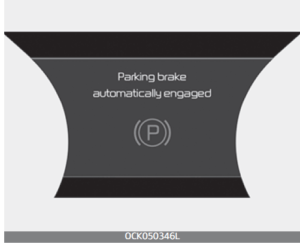
When the EPB is applied from Auto Hold, a warning will sound and a message will appear.

When the conversion from Auto Hold to EPB is not working properly a warning will sound and a message will appear.
NOTICE
When this message is displayed, the Auto Hold and EPB may not operate. For your safety, depress the brake pedal.

If you do not apply the brake pedal when you release the Auto Hold by pressing the [AUTO HOLD] switch, a warning will sound and a message will appear.

When you press the [AUTO HOLD] switch, if the driver’s door and engine hood are not closed or the driver’s seat belt is unfastened, a warning will sound and a message will appear on the LCD display. At this moment, press the [AUTO HOLD] button after closing the driver’s door and engine hood and fastening the seat belt.
2023 Kia Stinger Specs, Price, Features and Mileage (Brochure)
Anti-lock Brake System (ABS)
ABS (or ESC) will not prevent accidents due to improper or dangerous driving manoeuvres. Even though vehicle control is improved during emergency braking, always maintain a safe distance between you and objects ahead. Vehicle speeds should always be reduced during extreme road conditions. The vehicle should be driven at reduced speeds in the following circumstances:
- When driving on rough, gravel, or snow-covered roads
- When driving with tire chains installed
- When driving on roads where the road surface is pitted or has different surface heights.
Driving in these conditions increases the stopping distance for your vehicle.
The ABS continuously senses the speed of the wheels. If the wheels are going to lock, the ABS system repeatedly modulates the hydraulic brake pressure to the wheels.
When you apply your brakes under conditions that may lock the wheels, you may hear a tik sound from the brakes, or feel a corresponding sensation in the brake pedal. This is normal and it means your ABS is active.
In order to obtain the maximum benefit from your ABS in an emergency situation, do not attempt to modulate your brake pressure, and do not try to pump your brakes. Press your brake pedal as hard as possible to allow the ABS to control the force being delivered to the brakes.
NOTICE
A click sound may be heard in the engine compartment when the vehicle begins to move after the engine is started. These conditions are normal and indicate that the anti-lock brake system is functioning properly.
- Even with the anti-lock brake system, your vehicle still requires sufficient stopping distance. Always maintain a safe distance from the vehicle in front of you.
- Always slow down when cornering. The anti-lock brake system cannot prevent accidents resulting from excessive speeds.
- On loose or uneven road surfaces, the operation of the anti-lock brake system may result in a longer stopping distance than for vehicles equipped with a conventional brake system.
The ABS warning light will stay on for approximately 3 seconds after the ENGINE START/STOP button is ON. During that time, the ABS will go through self-diagnosis and the light will go off if everything is normal. If the light stays on, you may have a problem with your ABS. Contact an authorized Kia dealer as soon as possible.
- When you drive on a road having poor traction, such as an icy road, and have operated your brakes continuously, the ABS will be active continuously and the ABS warning light may illuminate. Pull your vehicle over to a safe place and stop the engine.
- Restart the engine. If the ABS warning light goes off, then your ABS system is normal. Otherwise, you may have a problem with the ABS. Contact an authorized Kia dealer as soon as possible.
NOTICE
When you jump-start your vehicle because of a drained battery, the engine may not run as smoothly and the ABS warning light may turn on at the same time. This happens because of low battery voltage. It does not mean your ABS has malfunctioned.
- Do not pump your brakes!
- Have the battery recharged before driving the vehicle?
Electronic Stability Control (ESC)
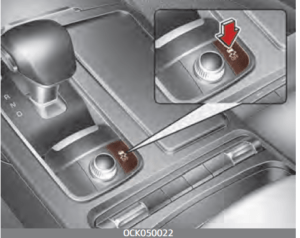
The Electronic Stability Control
(ESC) the system is designed to stabilize the vehicle during cornering manoeuvres. ESC checks where you are steering and where the vehicle is actually going. ESC applies the brakes on individual wheels and intervenes with the engine management system to stabilize the vehicle.
Electronic Stability Control (ESC) will not prevent accidents. Excessive speed in turns, abrupt manoeuvres, and hydroplaning on wet surfaces can still result in serious accidents. Only a safe and attentive driver can prevent accidents by avoiding manoeuvres that cause the vehicle to lose traction. Even with ESC installed, always follow all the normal precautions for driving – including driving at safe speeds for the conditions.
WARNING
For maximum protection, always wear your seat belt. No system, no matter how advanced, can compensate for all driver errors and/or driving conditions. Always drive responsibly.
The Electronic Stability Control
(ESC) the system is an electronic system designed to help the driver maintain vehicle control under adverse conditions. It is not a substitute for safe driving practices. Factors including speed, road conditions, and driver steering input can all affect whether ESC will be effective in preventing a loss of control. It is still your responsibility to drive and corner at reasonable speeds and to leave a sufficient margin of safety.
When you apply your brakes under conditions that may lock the wheels, you may hear a tik sound from the brakes, or feel a corresponding sensation in the brake pedal. This is normal and it means your ESC is active.
NOTICE
A click sound may be heard in the engine compartment when the vehicle begins to move after the engine is started. These conditions are normal and indicate that the Electronic Stability Control System is functioning properly.
ESC operation
ESC ON condition
- When the ENGINE START/STOP button is turned ON, ESC and ESC OFF indicator lights illuminate for approximately 3 seconds, then ESC is turned on.
- Press the ESC OFF button for at least half a second after turning the ignition ON to turn ESC off. (ESC OFF indicator will illuminate). To turn the ESC on, press the ESC OFF button (the ESC OFF indicator light will go off).
- When starting the engine, you may hear a slight ticking sound. This is the ESC performing an automatic system self-check and does not indicate a problem.
When operating
When the ESC is in operation, the ESC indicator light blinks.
- When the Electronic Stability Control is operating properly, you can
feel a slight pulsation in the vehicle. This is only the effect of the brake control and indicates nothing unusual. - When moving out of the mud or driving on a slippery road, pressing the accelerator pedal may not cause the engine rpm (revolutions per minute) to increase.
ESC operation off
ESC OFF state
There are 2 types of ESC OFF states; Traction Control disabled and Traction & Stability Control disabled.
If the ignition is turned off when ESC is off, ESC remains off.
Upon restarting the engine, the ESC will automatically turn on again.
- ESC off state 1
Type A

Type B

To cancel ESC operation, press the ESC OFF button (ESC OFF ) shortly (ESC OFF indicator light (ESC OFF ) illuminates). At this state, the engine control function does not operate. It means the traction control function does not operate. Brake control function only operates.
ESC off state 2
Type A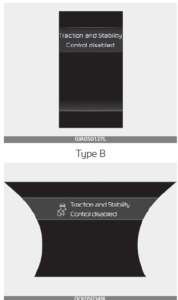
To cancel ESC operation, press the ESC OFF button (ESC OFF ) for more than 3 seconds. ESC OFF indicator light (ESC OFF ) illuminates and an ESC OFF warning chime will sound. At this state, the engine control function and brake control function does not operate. It means the car stability control function does not operate anymore.
Indicator light
ESC indicator light
ESC OFF indicator light
When the ENGINE START/STOP button is turned ON, the indicator light illuminates, then goes off if the ESC system is operating normally.
The ESC indicator light blinks whenever ESC is operating or illuminates when ESC fails to operate.
The ESC OFF indicator light comes on when the ESC is turned off with the button.
WARNING
Electronic Stability Control
Drive carefully even though your vehicle has Electronic Stability Control. It can only assist you in maintaining control under certain circumstances.
ESC OFF usage
When driving
- ESC should be turned on for daily driving whenever possible.
- To turn ESC off while driving, press the ESC OFF button while driving on a flat road surface.
WARNING
Operating ESC
Never press the ESC OFF button while ESC is operating (ESC indicator light blinks).
If ESC is turned off while ESC is operating, the vehicle may slip out of control.
NOTICE
- When operating the vehicle on a dynamometer, ensure that the ESC is turned off (ESC OFF light illuminated). If the ESC is left on, it may prevent the vehicle speed from increasing and result in a false diagnosis.
- Turning the ESC off does not affect ABS or brake system operation.
Vehicle Stability Management (VSM)
This system provides further enhancements to vehicle stability and steering responses when a vehicle is driving on a slippery road or a vehicle detects changes in the coefficient of friction between right wheels and left wheels when braking.
WARNING
Tire/Wheel size
When replacing tires and wheels, make sure they are the same size as the original tires and wheels installed. Driving with varying tire or wheel sizes may diminish any supplemental safety benefits of the VSM system.
VSM operation
When the VSM is in operation, the ESC indicator light ( ) blinks.
When the vehicle stability management is operating properly, you can feel a slight pulsation in the vehicle and/or abnormal steering responses EPS (Electric Power Steering). This is only the effect of brake and EPS control and indicates nothing unusual.
The VSM does not operate when: Driving on a sloping road such as a gradient or incline
- Driving in reverse
- ESC OFF indicator light ( ) remains on the instrument cluster
- EPS (Electric Power Steering) indicator light remains on the instrument cluster
VSM operation off
If you press the ESC OFF button to turn off the ESC, the VSM will also cancel and the ESC OFF indicator light ( ) illuminates.
To turn on the VSM, press the button again. The ESC OFF indicator light goes out.
WARNING
Vehicle stability management
Drive carefully even though your vehicle has Vehicle stability management. It can only assist you in maintaining control under certain circumstances.
Malfunction indicator
The VSM can be deactivated even if you don’t cancel the VSM operation by pressing the ESC OFF button. It indicates that a malfunction has been detected somewhere in the Electric Power Steering system or VSM system. If the ESC indicator light ( ) or EPS warning light remains on, take your vehicle to an authorized Kia dealer and have the system checked.
The system is not a substitute for safe driving practices but a supplementary function only. It is the responsibility of the driver to always check the speed and the distance to the vehicle ahead. Always hold the steering wheel firmly while driving.
- Your vehicle is designed to activate according to the driver’s intention, even with installed VSM. Always follow all the normal precautions for driving at safe speeds for the conditions including driving in inclement weather and on slippery roads.
WARNING
For maximum protection, always wear your seat belt. No system, no matter how advanced, can compensate for all driver errors and/or driving conditions. Always drive responsibly.
Hill-start Assist Control (HAC)
A vehicle has the tendency to roll back on a steep hill when it starts to go after stopping. The Hill-start Assist Control (HAC) prevents the vehicle from rolling back by applying Driving your vehicle
brakes automatically for about 2 seconds. The brakes are released when the accelerator pedal is depressed or after about 2 seconds.
The HAC is activated only for about 2 seconds, so when the vehicle is starting off always depress the accelerator pedal.
WARNING
Maintaining Brake Pressure on the Incline
HAC does not replace the need to apply brakes while stopped on an incline. While stopped, make sure
you maintain brake pressure sufficient to prevent your vehicle from rolling backwards and causing an accident. Dont release the brake pedal until you are ready to accelerate forward.
Good braking practices
- Check to be sure the parking brake is not engaged and the parking brake indicator light is out before driving away.
- Driving through water may get the brakes wet. They can also get wet when the vehicle is washed. Wet brakes can be dangerous! Your vehicle will not stop as quickly if the brakes are wet. Wet brakes may cause the vehicle to pull to one side.
- To dry the brakes, apply the brakes lightly until the braking action returns to normal, taking care to keep the vehicle under control at all times. If the braking action does not return to normal, stop as soon as it is safe to do so and call an authorized Kia dealer for assistance.
- Don’t coast down hills with the vehicle out of gear. This is extremely hazardous. Keep the vehicle in gear at all times, use the brakes to slow down, then shift to a lower gear so that engine braking will help you maintain a safe speed.
- Don’t “ride” the brake pedal. Resting your foot on the brake pedal while driving can be dangerous because the brakes might overheat and lose their effectiveness. It also increases the wear of the brake components.
- If a tire goes flat while you are driving, apply the brakes gently and keep the vehicle pointed straight ahead while you slow down. When you are moving slowly enough for it to be safe to do so, pull off the road and stop in a safe place.
- If your vehicle is equipped with an Automatic Transmission, don’t let your vehicle creep forward. To avoid creeping forward, keep your foot firmly on the brake pedal when the vehicle is stopped.
- Be cautious when parking on a hill.
Firmly engage the parking brake and place the shift lever in P (automatic transmission). If your vehicle is facing downhill, turn the front wheels into the curb to help keep the vehicle from rolling.
If your vehicle is facing uphill, turn the front wheels away from the curb to help keep the vehicle from rolling. If there is no curb or if it is required by other conditions to keep the vehicle from rolling, block the wheels. - Under some conditions, your parking brake can freeze in the engaged position. This is most likely to happen when there is an accumulation of snow or ice around or near the rear brakes or if the brakes are wet. If there is a risk that the parking brake may freeze, apply it only temporarily while you put the shift lever in P (automatic transmission) and block the rear wheels so the vehicle cannot roll. Then release the parking brake.
- Do not hold the vehicle on an incline with the accelerator pedal. This can cause the transmission to overheat. Always use the brake pedal or parking brake.
Electronic Control Suspension (ECS) (if equipped)
The Electronic Control Suspension (ECS) controls the vehicle suspension automatically to maximize driving comfort by taking into account the driving conditions such as speed, the surface of the road, cornering, stop-ping requirements, and acceleration. If the ECS warning message Check Electronic Suspension comes on, you may have a problem with the ECS system. In this case, have your vehicle inspected by an authorized Kia dealer.
Brake Assist System (BAS)
The BAS system is to reduce or to avoid accident risk. It recognizes the distance from the vehicle ahead or the pedestrian through the sensors (i.e. radar and camera), and, if necessary, warns the driver of accident risk with the warning message or the warning alarms.
WARNING
Brake Assist System (BAS) Limitations
The BAS system is a supplemental system and is not a substitute for safe driving practices. It is the responsibility of the driver to always check the speed and distance to the vehicle ahead to ensure it is safe to use.
NOTICE
Take the following precautions when using the Brake Assist System (BAS):
This system is only a supplemental system and it is not intended to, nor does it replace the need for extreme care and attention of the driver. The sensing range and objects detectable by the sensors are limited. Pay attention to the road conditions at all times. NEVER drive too fast in accordance with the road conditions or while cornering. Always drive cautiously to prevent unexpected and sudden situations from occurring. BAS does not stop the vehicle completely and does not avoid collisions.
Low Vacuum Assist (LVA) (if equipped)
Low Vacuum Assist (LVA) amplifies the hydraulic brake force to assist the driver under a low or temporarily low engine vacuum. You may hear a motor running sound and feel a slight vibration in the brake pedal like ABS operating. This indicates that the Supplemental Brake System is working to maintain braking power.
WARNING
Low Vacuum Assist (LVA) will not prevent accidents due to improper or dangerous driving manoeuvres.
FAQ
The 2022 Kia Stinger typically comes with a four-wheel disc brake system.
Yes, the Stinger offers performance-oriented Brembo brakes as an option on certain trim levels.
The Stinger’s brake system includes four brake rotors, one for each wheel.
Yes, the 2022 Kia Stinger comes standard with an anti-lock braking system (ABS) to prevent wheel lockup during hard braking.
The ABS helps maintain steering control and stability during emergency braking by modulating brake pressure to each wheel independently.
The Stinger may come equipped with advanced brake assist systems that provide additional braking force in emergency situations to help reduce stopping distance.
The brake pedal in the Stinger typically provides a firm and responsive feel, offering drivers good control over braking.
Regenerative braking is not a standard feature in the 2022 Kia Stinger, but it may be available on certain hybrid or electric models if they are offered.
Some high-performance versions of the Stinger may include brake cooling ducts or vents to help maintain consistent brake performance during aggressive driving.
The 2022 Kia Stinger typically features an electronic parking brake that can be engaged and disengaged with the push of a button.
Yes, most modern vehicles, including the 2022 Kia Stinger, come with brake pad wear indicators to alert drivers when it’s time to replace the brake pads.
The brake system settings may be influenced by drive modes or performance packages on certain trim levels, allowing drivers to customize the brake feel to some extent.
The Stinger may come equipped with features like electronic stability control (ESC) and hill start assist to enhance safety during braking and acceleration.
Brake service intervals can vary depending on driving habits, but it’s generally recommended to have the brakes inspected and serviced as needed, following the manufacturer’s recommendations.
Kia may offer warranties and maintenance packages that include brake-related services, so it’s a good idea to inquire with your local Kia dealership for specific details on available coverage.
Useful Link
View Full PDF: Kia Stinger 2022 User Guide
Download Manuals: https://owners.kia.com/content/owners/en/manuals.html
2023 Kia Stinger Specs, Price, Features and Mileage (Brochure)

